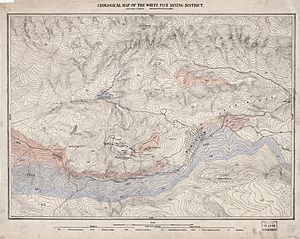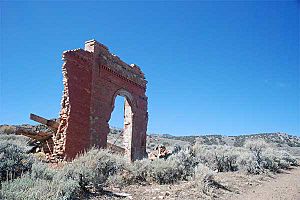Treasure Hill (White Pine County, Nevada) facts for kids

Treasure Hill is a part of the White Pine Range in White Pine County, Nevada. It's located east of Mount Hamilton. This hill became famous for a huge silver mining boom in the late 1860s. Between 1867 and 1880, mines in the area produced silver worth about $20 million! This exciting discovery brought thousands of people to new towns. These included Hamilton, which was at the base of the hill, and Treasure City, located closer to the top.
However, by early 1881, the mining slowed down a lot. The silver was found in scattered deposits, not in long-lasting veins within the rocks. This meant the silver ran out quickly. Because of this, by 1888, only 24 people lived there. The once busy towns of Hamilton, Treasure City, and Shermantown became ghost towns.
Contents
History of the Silver Rush
The first explorers in this area were looking for copper and other metals. But then, in the autumn of 1867, silver was found by chance! A Native American man known as "Napias Jim" (napias means silver in the Shoshoni language) showed some rich silver ore to his friend, a blacksmith named A. J. Lesthers. Lesthers melted it down into a silver button. At that time, silver was worth $1.32 per ounce.
The place where this ore was found became the Hidden Treasure Mine. One ton of ore from this mine was worth $500 to $800! Another mine produced $800 to $1,000 per ton. Then, a third mine hit the jackpot with pure silver, sometimes called "putty" silver. This amazing find could produce $15,000 to $20,000 per ton of ore!
Soon, the top of Treasure Hill, which used to be empty and windy, was covered with stores, mining claims, and drilling sites everywhere. Everyone who wanted to get rich quickly, from promoters to prospectors, rushed to Treasure Hill. This discovery in the spring of 1868 led to a very successful but short-lived boom. People later called it the "shortest and most intense mining rush." The hill was named "Treasure Hill" because of these amazing silver finds.
Over two years, until 1887, the Treasure Hill mines produced silver worth $22,000,000. With all this wealth, the early miners loved to have fun. They enjoyed "horseracing, gambling, and celebrations of all sorts" in nearby Hamilton. This boom led to three main towns growing up: Hamilton at the bottom of the hills, Treasure City on the hills, and Shermantown, which was mainly a town for miners.
Mining Towns of Treasure Hill
Hamilton: A Bustling Town
A town was set up at the foot of Treasure Hill in 1868 to support the mines. It was first called Cave City, but its name was later changed to Hamilton. The discovery of silver caused a huge excitement, known as "White Pine Fever." Hotels and saloons quickly opened. In 1869, about 10,000 people were living there temporarily.
Once water was brought to the towns, several mills were built to process the ore. Large smelting works, which cost $60,000, were built to melt the silver. A 10-stamp mill called Nevada started working on May 20, 1869. A bigger 20-stamp mill, called Big Smoky or Treasure Hill, opened on May 24, 1869. More mills, like the 24-stamp Manhattan, were added on June 1, 1869.
Treasure City: At the Peak
Treasure City was located near the very top of Treasure Hill. It was about 2.5 miles (4 km) from Hamilton. This town was right in the middle of the richest silver discoveries.
Shermantown: A Miner's Home
By 1869, Shermantown had about 3,000 people. It depended completely on the mines at Treasure Hill. Many towns, with populations up to 10,000 people, grew in the county because of the silver mining success on Treasure Hill.
Swansea: A Mill Town
Swansea was founded in 1869, about 3.25 miles (5.2 km) west of Hamilton. It was named after Swansea, Wales, which was famous for smelting copper. The Swansea Mill processed ores from Treasure City and Hamilton. At the height of the Treasure Hill boom, people in Swansea thought even bigger mills would be needed. They even planned to extend their main street to Shermantown, which was less than 1 mile (1.6 km) away. However, Shermantown took over Swansea in late 1869. Today, only some rock ruins remain.
Boom and Decline of the Silver Rush
The "White Pine rush" led to the creation of White Pine County on April 1, 1869. Hamilton was its largest town and the first county seat. However, this rush started to fade in the 1870s when new silver discoveries were made in other places like Cherry Creek and Ward.
In 1873, a big fire swept through Hamilton. This fire also affected other towns nearby and caused many people to move to other mining areas. Even so, miners later found more silver ore deeper in the hill. The mining continued in the late 1870s and early 1880s. But another fire in 1885 destroyed the courthouse and much of Hamilton. This fire marked the end of the good times and removed most signs that a rich mining camp had ever been there.
Later Mining Activity
There was a brief return of mining in the 1920s. A company called Treasure Hills Deposit Mining Company started digging. They dug a shaft 250 feet (76 m) deep and produced $1.2 million worth of silver in two years. But they closed down in 1928. Mining activity was later tried again using a new method called cyanide leaching.
Today, Treasure Hill is part of the Humboldt-Toiyabe National Forest, which was created in 1908.
Geology: Why the Boom Ended
The silver ore found at Treasure Hill was very rich. It contained silver, silica, calcite, and manganese oxide mixed in limestone. The mines at Treasure Hill were known for having "exceptional occurrences" of silver. For example, the Eberhardt Mine had a huge 6-ton mass of silver!
However, when geologists from the U.S. and Britain studied the area, their findings were not good news for the mines. They discovered that the ores were just scattered deposits. They were not connected to long-lasting veins of silver within the rocks. This meant the silver would run out quickly. This discovery, along with miners' strikes and bad weather, caused many people to leave the mining area in 1870.
Images for kids



